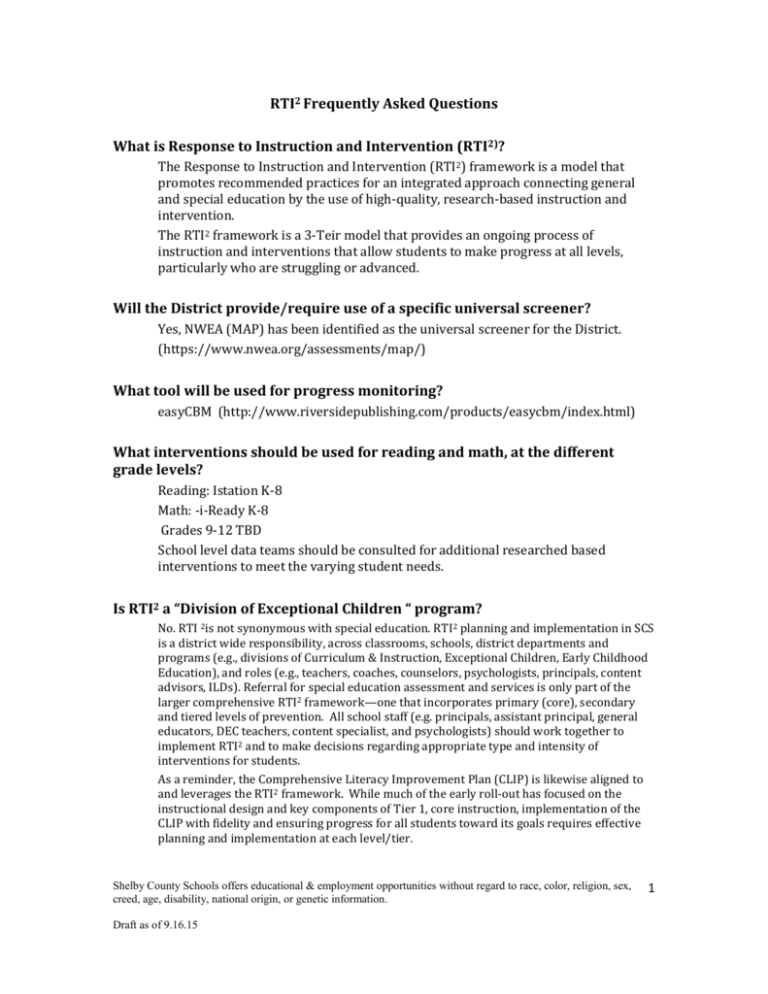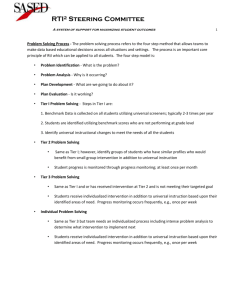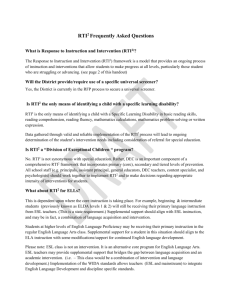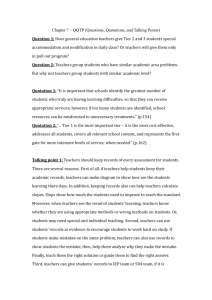RTI 2 Frequently Asked Questions
advertisement

RTI2 Frequently Asked Questions What is Response to Instruction and Intervention (RTI2)? The Response to Instruction and Intervention (RTI2) framework is a model that promotes recommended practices for an integrated approach connecting general and special education by the use of high-quality, research-based instruction and intervention. The RTI2 framework is a 3-Teir model that provides an ongoing process of instruction and interventions that allow students to make progress at all levels, particularly who are struggling or advanced. Will the District provide/require use of a specific universal screener? Yes, NWEA (MAP) has been identified as the universal screener for the District. (https://www.nwea.org/assessments/map/) What tool will be used for progress monitoring? easyCBM (http://www.riversidepublishing.com/products/easycbm/index.html) What interventions should be used for reading and math, at the different grade levels? Reading: Istation K-8 Math: -i-Ready K-8 Grades 9-12 TBD School level data teams should be consulted for additional researched based interventions to meet the varying student needs. Is RTI2 a “Division of Exceptional Children “ program? No. RTI 2is not synonymous with special education. RTI2 planning and implementation in SCS is a district wide responsibility, across classrooms, schools, district departments and programs (e.g., divisions of Curriculum & Instruction, Exceptional Children, Early Childhood Education), and roles (e.g., teachers, coaches, counselors, psychologists, principals, content advisors, ILDs). Referral for special education assessment and services is only part of the larger comprehensive RTI2 framework—one that incorporates primary (core), secondary and tiered levels of prevention. All school staff (e.g. principals, assistant principal, general educators, DEC teachers, content specialist, and psychologists) should work together to implement RTI2 and to make decisions regarding appropriate type and intensity of interventions for students. As a reminder, the Comprehensive Literacy Improvement Plan (CLIP) is likewise aligned to and leverages the RTI2 framework. While much of the early roll-out has focused on the instructional design and key components of Tier 1, core instruction, implementation of the CLIP with fidelity and ensuring progress for all students toward its goals requires effective planning and implementation at each level/tier. Shelby County Schools offers educational & employment opportunities without regard to race, color, religion, sex, creed, age, disability, national origin, or genetic information. Draft as of 9.16.15 1 Is RTI2 the only means of identifying a child with a specific learning disability? RTI2 is the only means of identifying a child with a Specific Learning Disability in basic reading skills, reading comprehension, reading fluency, mathematics calculations, mathematics problem-solving or written expression. Data gathered through valid and reliable implementation of the RTI2 process will lead to ongoing determination of the student’s intervention needs including consideration of referral for special education. When should SWD be pulled for interventions? Students cannot be pulled out of the core instructional blocks to receive special education services. What guidance should be provide to schools with IEP's that contain language allowing for students to be pulled during the core instructional block? Students cannot be pulled out of the core instructional block to receive special education services. If an IEP dictates that students be pulled during the core instructional block, the special education teacher should talk to the special education advisor to review the IEP and determine if an IEP meeting needs to be held to review services. Additional guidance will be forthcoming for co-teaching. When should primary CLUE students be pulled to receive CLUE instruction? Immediate CLUE students (gr. 3-5)? CLUE teachers are literacy/language teachers, too. The students are covered under special education and are entitled to their services with us through the pullout program, so we will be contributing to their literacy instruction. Our teachers are going through the same training and preparation to do this, and even when we use different content, we incorporate the district guidelines for literacy while students are with us. Keep in mind that this will only be once a week that they may be pulled for a portion of this time; nonetheless, we will contribute to the advancement of literacy in the district. CLUE students typically are advanced readers; however, if we see that students need additional differentiation in the area of literacy, then we will provide that in their time in CLUE. What are the expectations for high schools this year? Many of the high schools indicated that they don't have an intervention block. Is there a course code for the intervention block for secondary students? The phase in for High school RTI2is not required until July, 2016. SLD determination is based on the discrepancy model, however, state standards do require evidence of intervention and progress monitoring for at least 8-10 weeks (but does not include all elements of RTI2 such as parent letters, fidelity checks, etc.) Shelby County Schools offers educational & employment opportunities without regard to race, color, religion, sex, creed, age, disability, national origin, or genetic information. Draft as of 9.16.15 2 What does a school do when a student transfers mid-year from a Shelby County School (SCS)? The RTI² process is focused on prevention and early intervention and uses assessment data for instruction, intervention and transitions between tiers. When a student enters mid-term, or any time after the universal screening and benchmark assessment is given, the school staff should ensure that the data from previous schools transfer to the new school (usually once Power School SMS has updated). Once the student’s universal screening, benchmarking, and progress monitoring data transfer to the new school, the RTI2 Data Team should review the new student’s Intervention Plan and revise as needed. What does a school do when a student transfers mid-year from a non-SCS school? When a student enters mid-term, or any time after the universal screening and/or benchmark assessment is given, the school staff should administer the universal screener and/or benchmark assessment to the new student as soon as that student’s demographic information uploads. How is English Language Learner (ELL) status determined? English Language Learner status is determined by an English Language Learner’s WIDA ACCESS score. . All students scoring between a 1.0 and 4.9 are considered English Language Learners. Specific categories related to WIDA ACCESS Scores are: 1 (Entering); 2 (Emerging); 3 (Beginner); 4 (Expanding); 5 (Bridging); 6 (Reaching). ELL Students transition out of ELL status by achieving a WIDA ACCESS score of 5.0 in Literacy in combination with a 5.0 in the Overall proficiency score. Who provides tiered interventions for students receiving ESL services? All ELLs will complete the Standards-Based Universal Screener and the Skills-Based Benchmark Assessment (if applicable) in English. For ELLs who score at or below the 24 th percentile on the Skills-Based Benchmark Assessment, English Proficiency levels (WIDA ACCESS scores) should be used to determine if Tier 2 instruction is needed, or if additional English Language Development is needed. ELL students at higher levels of English proficiency may be receiving Tier 1 ELA instruction from regular classroom teachers with collaboration and support from ESL teachers. Thoughtful consideration should be made for students in this category to determine if the district interventions might be appropriate or if the needs are related to English language development. Progress monitoring should give indications as to whether or not the selected intervention is effective. Students who have been in the ESL program for extended period of time and are not progressing in English Language Proficiency benchmarks or on the universal screener may need to be considered for Tier 3 interventions. Their needs may be unrelated to English Shelby County Schools offers educational & employment opportunities without regard to race, color, religion, sex, creed, age, disability, national origin, or genetic information. Draft as of 9.16.15 3 language development. Who provides tiered interventions for students receiving special education services? Special Education students, who have been identified as having a Specific Learning Disability (SLD), should receive skill based interventions in their identified area of disability (e.g., reading fluency, math calculation). These interventions should be provided by the special education teacher during the Tier 3 Intervention block. If a student scores within Tier 2 or Tier 3 in an area other than one he or she is eligible for special education services (e.g., instructional resource support for reading comprehension, but Tier 3 in math calculation), then the RTI2 data team (including the special education teacher) should carefully consider how the child should also receive tiered interventions in the unidentified area. If so, then interventions and progress monitoring will be provided within the general education classroom for the unidentified skill-deficit area. Students who have IEPs and have been identified as having a non-SLD disability (e.g. Other Health Impaired, Developmental Delay), should receive Tier 2 or Tier 3 interventions in the general education classroom. The special education teacher works on IEP goals that may or may not be academic when these students receive instructional resource. What are the SCS recommended time frames for Tier I, II, & III instruction? Tier I Tier I ELA/Writing Math Kindergarten 150 minutes daily First 150 minutes daily Second 150 minutes daily Third Minimum of 90 minutes daily 60 minutes daily 60 minutes daily 75 minutes daily 90 minutes daily (120 minutes recommended) The reading block should last for approximately 90 minutes in K-3 classrooms and for approximately 50 minutes in Pre-K classrooms. The writing block should last for approximately 30 minutes in K-3 classrooms. Tier I ELA/Writing Gr. 4-5 Fourth Grade Minimum of 90 minutes daily (120 minutes recommended) Fifth Grade Minimum of 90 minutes daily (120 minutes recommended) Shelby County Schools offers educational & employment opportunities without regard to race, color, religion, sex, creed, age, disability, national origin, or genetic information. Draft as of 9.16.15 4 Math Gr. 3-5 90 minutes daily 90 minutes daily 6-12 ELA /Math minimum recommended instructional times: Tier I 6-8 (traditional) 6-8 (block) 9-12 (traditional) 9-12 (block) ELA/Math 55 (daily) ** 40 55 (daily)** 90 ** Grades 6-8: Whole Group: approximately 30 minutes Small Group: approximately 20 minutes Whole Group: approximately 5 minutes Minutes are not exact. Time will vary based on the needs of the students and the tasks. However, whole group instruction should not last the entire class period. Tier II Tier II Reading Mathematics Kindergarten 20 minutes 20 minutes Tier II Reading Mathematics Third 30 minutes 30 minutes First Grade 30 minutes 20 minutes Fourth 30 minutes 30 minutes Second Grade 30 minutes 30 minutes Fifth 30 minutes 30 minutes Tier II 6-8 (traditional) 6-8 (block) 9-12 (traditional) 9-12 (block) Reading 30 minutes 30 minutes 30 minutes Mathematics 30 minutes 30 minutes 30 minutes 30 minutes 30 minutes ** Time allotments fall within TDOE guidelines. Shelby County Schools offers educational & employment opportunities without regard to race, color, religion, sex, creed, age, disability, national origin, or genetic information. Draft as of 9.16.15 5 Tier III Tier III Reading Mathematics Kindergarten 40-45 minutes 40-45 minutes First Grade 45-60 minutes 40-45 minutes Tier III Reading Third 45-60 minutes Fourth 45-60 minutes Mathematics 45-60 minutes 45-60 minutes Tier III Reading 6-8 (traditional) 45-55 minutes 45-55 minutes 6-8 (block) 45-60 minutes 45-60 minutes Second Grade 45-60 minutes 45-60 minutes Fifth 45-60 minutes 45-60 minutes 9-12 9-12 (traditional) (block) 45-55 45-60 minutes minutes 45-55 45-60 minutes minutes ** Time allotments fall within TDOE guidelines. Shelby County Schools offers educational & employment opportunities without regard to race, color, religion, sex, creed, age, disability, national origin, or genetic information. Draft as of 9.16.15 6






